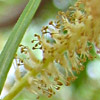Salix acmophylla (willow of the brook) is a common winter-deciduous tree that grows wild in Israel on river banks and other humid habitats. It has a wide crown, grows rapidly (“And he shall be like a tree planted by the rivers of water”). It reproduces readily by vegetative reproduction from broken branches that were swept by the current and became stuck in mud. It can reach a height of 8 meters, but usually not more than 5 meters.
The branches are pliant, reddish, the external ones hang down to the ground. The leaves are alternate, simple, dentate, pointed at the tip, accompanied by deciduous stipules. The following characteristics differentiate it from a similar species, Salix alba: The leaves of Salix alba are glabrous, lanceolate, narrow (they are less than 2 cm wide), the dentation of their margin is delicate and cannot be observed at all without a magnifying glass. The petiole is short, the upper side of the leaf is somewhat shiny, the lower side is bluish.
Salix acmophylla blooms in the spring, from March to May, concomitantly with the sprouting of the leaves. The inflorescence is made of a limp spike of tiny unisexual flowers (catkin). It is erect and short (2-3 cm), falls as a single unit. The flower lacks petals and sepals. Each flower is accompanied by a pilose or pappose bract. Willows are dioecous; each individual have either male flowers, which contain 4 or 5 stamens, or female flowers. The flowers secrete nectar, and are pollinated by insects, as well as by wind. The fruit is dry, opens in valves, multi-seed. It is carried on a petiole of 1-5 mm. Each seed is equipped with a tuft of hairs that helps its dispersal in the wind. The entire ground is often covered with threads of Salix seeds, and the air is also filled with them.
Salix acmophylla is common in all parts of Israel, except for the Negev.
Its uses include: light and soft wood, which is good for light furniture and for building boats, as well as for producing wood coal. The pliant branches are beautiful for weaving baskets. The bark is used for extraction of tannin. The willow is considered a good source of bee food. The bark and the leaves are used in folk medicine for pain relief, for lowering fever and for healing infections. Salicyl, the active compond in aspirin, was first isolated from the bark of Salix trees and is named after the tree’s scientific name.
Archeological remains dated to 12,000 years ago of Salix wood that was used by man were discovered in the Nahal Cave on Mount Carmel, and from 5,000-7,000 years ago at Jericho.
Its global distribution spreads over the Eastern Mediterranean countries and the Middle East.
The genus contains 500 species, and they are common mainly in temperate and cold regions of the Northern Hemisphere both in the Old World and in the New World. It is difficult to differentiate between the species, especially in light of the fact that hybrids between species are common. One other species grows in Israel, and perhaps 3 more very rare species, as well as one domesticated species – Salix babylonica (Weeping Willow), whose branches hang down as if weeping, reminiscent of “By the rivers of Babylon, there we sat down, yea, we wept, when we remembered Zion. We hanged our harps upon the willows in the midst thereof” (Psalms 137: 1-2). It originates from China.
The Salicaceae family is considered a primitive family among the dicotyledonous plants and among the angiosperms. It is the only family in its order. The family contains only two genera: Salix and Populus.
It is claimed by some that the willow mentioned in the scriptures is what we today call poplar, and that the poplar in the scriptures is a willow, as mentioned by Rav Hisda in Tractate Sabbath (36: 71): “Since the destruction of the Temple the name willow was exchanged for poplar and the name poplar for willow”.
Written by Mike Livne






